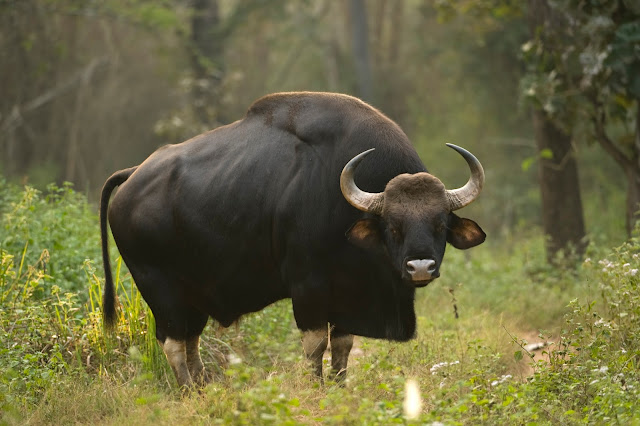Dhole- Indian Wild Dog
- In my previous 3 posts, I mention about Asiatic Lions, Royal Bengal Tiger, Snow leopard.
- All are endangered species and all are members of Big Cat family.
- After cats, it is time for "Dog Family".
Introduction Part
- The dhole is a canid native to Central, South and Southeast Asia. Other English names for the species include Asiatic Wild Dog, Indian Wild Dog, Whistling Dog, Red Dog, Red Wolf and Mountain Wolf.
Characteristics
- Adults may weight over 18 kg, with females usually weighting 4.5 kg lesser than males.
- It stands 17-22 inches at the shoulder and measures three feet in body length.
- Like the African dogs, its ears are rounded rather than pointed. It has 6-7 pairs of teats, sometimes eight.
- The general tone of the fur is reddish, with brightest hues occurring in winter.
Social and Territorial Behaviour
- Dholes are more social than grey wolves, and have less of a dominance hierarchy, as seasonal scarcity of food is not a serious concern for them.
- In this manner they closely resemble African Wild Dogs in social structure.
- They live in clans rather than packs, as the latter term refers to a group of animals that always hunt together.
- In contrast, dhole clans frequently break into a small packs of 3-5 animals, particularly in the spring season, as this is the optimal numbers for catching fawns.
- Dominant dholes are hard to identify, as they do not engage in dominance displays as wolves do, though other clan members will show submissive behaviour towards them.
- Inter group fighting is rarely observed.
Interesting Facts
- The dhole has some extraordinary vocal calls - it can whistle, scream, mew and even cluck like a chicken.
- It can urinate while doing a handstand on its front two legs.
- Its dental formula is unique among the dog family.
- It is a capable swimmer and often drives its prey into water.
- It has amazing jumping powers and can reach a vertical height of at least 2.3 metre.
Did you know?
- Tigers are dangerous opponents for dholes, as they have sufficient strength to kill a single dhole with a paw strike.
Reproduction
- In India, the mating season occurs between mid-October and January.
- Unlike, wolf packs, dhole clans may contain more than one breeding female. More than one female dhole may den and rear their litters together in the same den.
- During mating, the female assumes a crouched, cat-like position.
- The gestation period lasts 60-63 days, with litter sizes averaging 4-6 pups.
- Their growth rate is much faster than that of wolves. Pups are suckled at least 58 days. During this time , the pack feeds the mother at the den site.
- They remain at the den site 70-80 days. By the age of six months, pups accompany the adults on hunts and will assist in killing large prey such as sambar by the age of eight months.
- Maximum longevity in captivity is 15-16 years.
Where we can see dhole in India?
- The dhole is found in Assam, Gujarat, Bengal, Kashmir, Tamilnadu, North Western part of India.
- They are also spotted in the Corbett, Chitwan and Kanha National Park in India.
Conservation Program
- The Dhole is protected under Schedule 2 of the wild life Protection Act, 1972.
- The creation of reserves under Project Tiger provided some protection for dhole population sympatric with tigers.
- In 2014, the Indian government sanctioned its first dhole conservation breeding centre at the Indira Gandhi Zoological Park in Visakhapatnam.




Comments
Post a Comment